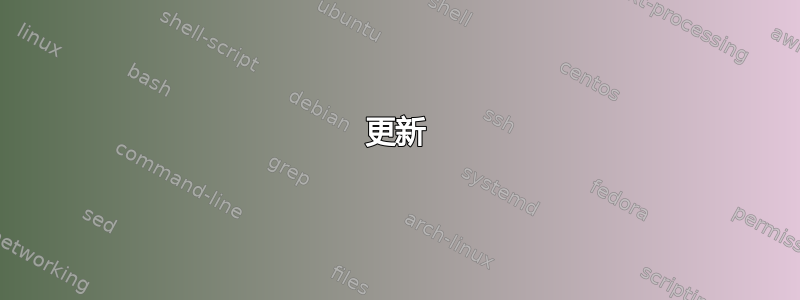
我有以下图片:
\documentclass{article}
\usepackage[pdftex,active,tightpage]{preview}
\setlength\PreviewBorder{2mm}
\usepackage{tkz-fct}
\usetikzlibrary{arrows, decorations.pathreplacing}
\tikzstyle{line}=[very thick, black]
\tikzstyle{point}=[thick,fill=gray,gray]
\begin{document}
\begin{preview}
\begin{tikzpicture}
\tkzInit [xmin=0,xmax=21,ymin=0,ymax=7]
\begin{scriptsize}
\tkzGrid[color = gray!30!white]
\tkzAxeXY
\end{scriptsize}
\draw[line] (1,4) -- (6,1);
\draw[line] (2,1) -- (5,4);
\draw[line] (3,1) -- (6,4);
\draw[line] (4,1) -- (8,5);
\draw[line] (3,4) -- (9,3);
\draw[line] (7,2) -- (9,3);
\draw[line] (6,7) -- (9,1);
\draw[line] (11,1) -- (16,5);
\draw[line] (13,2) -- (14,2);
\draw[line] (14,1) -- (14,2);
\draw[line] (14,3) -- (15,2);
\draw[line] (15,4) -- (15,3);
\draw[line] (13,4) -- (13,3);
\draw[line] (17,3) -- (21,3);
\draw[line] (19,1) -- (19,5);
\draw[point] (1,4) circle (2pt);
\end{tikzpicture}
\end{preview}
\end{document}
看起来像这样:

我想在每条线的末端都画一个十字。我可以手动画,就像我在circle末端画的 (see (1|4)) 一样,但我想画一个十字。我该怎么做?
(我怎样才能使 tikz 风格point看起来像一个十字架?)
答案1
笔记:
- 我已经用宏上的
scriptsize选项替换了环境(甚至不存在)。font=\scriptsize\tkzAxeXY - 我使用过该
standalone课程。
和纯 TikZ你有几种可能性:
这
cross out形状库中的 为shapes.misc您提供了删除节点的可能性。通常这用于在文本上可视化某些内容(像这样),但使用选项minimum height并minimum width加上零,inner sep我们得到了一个明确的十字。线宽设置(thick)也可以识别。point/.style={ thick, draw=gray, cross out, inner sep=0pt, minimum width=4pt, minimum height=4pt, },point现在可以手动应用此节点:\node[point] at (1,4) {};或自动使用特殊样式
to path(如下line):to path={% works only with "to" and not "--" -- (\tikztotarget) node[at start,point] {} node [at end,point] {} \tikztonodes }这
plot路径TikZ 提供了与之前完全一样的功能,但有很多额外的“标记”。其pline风格与之前的风格类似line。它还包含以下every plot选项:pline/.style={% plot line every plot/.style={ mark=x, mark options={ gray, thick, }, mark size=4pt, }, very thick, black, },
代碼(形狀)
\documentclass[tikz,border=2mm]{standalone}
\usepackage{tkz-fct}
\usetikzlibrary{shapes.misc}
\tikzset{
line/.style={
very thick,
black,
to path={% works only with "to" and not "--"
-- (\tikztotarget) node[at start,point] {} node [at end,point] {} \tikztonodes
}
},
point/.style={
thick,
draw=gray,
cross out,
inner sep=0pt,
minimum width=4pt,
minimum height=4pt,
},
}
\begin{document}
\begin{tikzpicture}
\tkzInit [xmin=0,xmax=21,ymin=0,ymax=7]
\tkzGrid[color = gray!30!white]
\tkzAxeXY[font=\scriptsize]
\draw[line] (1,4) -- (6,1);
\draw[line] (2,1) to (5,4)
(3,1) to (6,4)
(4,1) to (8,5)
(3,4) to (9,3)
(7,2) to (9,3)
(6,7) to (9,1);
\draw[line] (11,1) to (16,5)
(13,2) to (14,2)
(14,1) to (14,2)
(14,3) to (15,2)
(15,4) to (15,3)
(13,4) to (13,3);
\draw[line] (17,3) to (21,3)
(19,1) to (19,5);
\path[every node/.style={point}]
node at (1,4) {}
node at (6,1) {};
\end{tikzpicture}
\end{document}
输出(形状)

代码(情节)
\documentclass[tikz,border=2mm]{standalone}
\usepackage{tkz-fct}
\tikzset{
pline/.style={% plot line
every plot/.style={
mark=x,
mark options={
gray,
thick,
},
mark size=4pt,
},
very thick,
black,
},
}
\begin{document}
\begin{tikzpicture}
\tkzInit [xmin=0,xmax=21,ymin=0,ymax=7]
\tkzGrid[color = gray!30!white]
\tkzAxeXY[font=\scriptsize]
\draw[pline] plot coordinates {(1,4) (6,1)}
plot coordinates {(2,1) (5,4)}
plot coordinates {(3,1) (6,4)}
plot coordinates {(4,1) (8,5)}
plot coordinates {(3,4) (9,3)}
plot coordinates {(7,2) (9,3)}
plot coordinates {(6,7) (9,1)};
\draw[pline] plot coordinates {(11,1) (16,5)}
plot coordinates {(13,2) (14,2)}
plot coordinates {(14,1) (14,2)}
plot coordinates {(14,3) (15,2)}
plot coordinates {(15,4) (15,3)}
plot coordinates {(13,4) (13,3)};
\draw[pline] plot coordinates {(17,3) (21,3)}
plot coordinates {(19,1) (19,5)};
\end{tikzpicture}
\end{document}
输出(图)

答案2
一个不同的想法,定义一个新的箭头形状,例如X(感谢 Qrrbrbirlbel 注意到这\pgarrowrightextend{0pt}是必要的):
\documentclass{article}
\usepackage{tikz}
\makeatletter
\pgfarrowsdeclare{X}{X}
{
\pgfutil@tempdima=0.3pt%
\advance\pgfutil@tempdima by.25\pgflinewidth%
\pgfutil@tempdimb=5.5\pgfutil@tempdima\advance\pgfutil@tempdimb by.5\pgflinewidth%
\pgfarrowsleftextend{+-\pgfutil@tempdimb}
\pgfarrowsrightextend{0pt}
}
{
\pgfutil@tempdima=0.3pt%
\advance\pgfutil@tempdima by.25\pgflinewidth%
\pgfsetdash{}{+0pt}
\pgfsetroundcap
\pgfsetmiterjoin
\pgfpathmoveto{\pgfqpoint{-5.5\pgfutil@tempdima}{-6\pgfutil@tempdima}}
\pgfpathlineto{\pgfqpoint{5.5\pgfutil@tempdima}{6\pgfutil@tempdima}}
\pgfpathmoveto{\pgfqpoint{-5.5\pgfutil@tempdima}{6\pgfutil@tempdima}}
\pgfpathlineto{\pgfqpoint{5.5\pgfutil@tempdima}{-6\pgfutil@tempdima}}
\pgfusepathqstroke
}
\makeatother
\begin{document}
\tikz{
\draw[X-X] (0,0) -- (2,1);
\draw[X-X] (0,2) -- (1,0);
}
\end{document}

使用箭头形状而不是节点形状会使 X 根据所画线的斜率旋转。这可能是一个优点,也可能是一个问题,取决于你想要什么。
更新
一个更简单的解决方案,使用相同的想法,是组合两个现有的箭头,而不是定义一个新的。 以下代码将产生与上述代码完全相同的结果(笔记此代码已从第一个版本修改。现在它确保 X 位于指定的端点):
\documentclass{article}
\usepackage{tikz}
\usetikzlibrary{arrows}
\pgfarrowsdeclarecombine[-12*(0.3pt+.25\pgflinewidth)-\pgflinewidth]
{X}{X}{angle 90 reversed}{angle 90 reversed}{angle 90}{angle 90}
\begin{document}
\tikz{
\draw[X-X] (0,0) -- (2,1);
\draw[X-X] (0,2) -- (1,0);
}
\end{document}
答案3
这只是 PSTricks 的另一个答案。
输入:
\documentclass[pstricks,border=12pt]{standalone}
\usepackage{pst-eucl}
\addtopsstyle{gridstyle}{gridlabels=0}
\begin{document}
\begin{pspicture}[showgrid](4,3)
\pstGeonode[
PointName=none,
PointSymbol={x,none,x},
dotscale=2]
(0,0){A}
(1,3){B}
(4,1){C}
\psline(A)(B)(C)
\end{pspicture}
\end{document}
输出:



